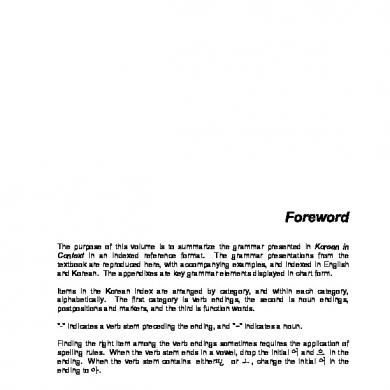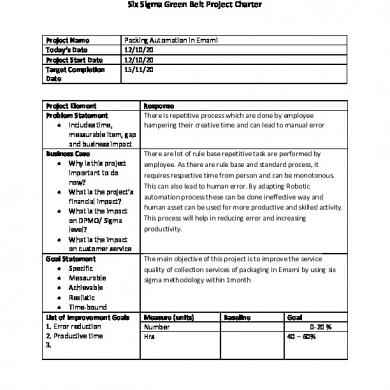Korean War
This document was uploaded by user and they confirmed that they have the permission to share it. If you are author or own the copyright of this book, please report to us by using this DMCA report form. Report DMCA
Overview
Download & View Korean War as PDF for free.
More details
- Words: 489
- Pages: 13
Loading documents preview...
KOREAN WAR ( June 25, 1950 – July 27, 1953)
Presented By: Shreya Chitrakar (Section ‘C’ )
Contents: • Who were involved? • How it began? • The war • How it ended? • Casualties and Economic Losses • Brief Timeline • References
Who were involved? North Korea
• Soviet Union • Leader: Kim Il Sung • Chinese leader :Mao Zedong
South Korea
• United States of America • Leader: Syngman Rhee • US President: Harry Truman • General Douglas MacArthur • New Us President: Dwight D. Eisenhower
Syngman Rhee (1875-1965)
Kim II-Sung (1912-1994)
How it began? • Before WWII Korea was under Imperial Japanese rule; after divided into two • North- Soviet Union, South- United States of America • Divided by 38th parallel boundary
The War • Outcome of cold war between two power blocks: US(capitalism) AND Soviet Union(communism) • the North Korean army pushed into Seoul on 25 June 1950 • a war to get the communists out of South Korea • 21 countries of the United Nations contributed to the UN force • US providing 88% of the UN's military personnel • North Korean army: well disciplined, well trained and well-equipped • South Korean army: frightened, confused and likely to flee • As a result the US army suffered badly
Continued • New strategy by US commander MacArthur; in September 1950, a UN counter-offensive launched at Incheon • cut off many North Korean troops, South Korean army crossed 38th parallel and reached Yalu river • China threatened, sent troops to North Korea and warned US about a possible full-scale war
How it ended? • In July 1951, US government started peace talks at Panmunjom • Peace talks lasted for 2 years • Two sides could not agree on whether prisoners of war should be forcibly repatriated • In 1952, new US president appointed; agreed with Chinese and North Koreans • Finally the signed the armistice agreement on July 27, 1953 and the war supposedly ended • No peace treaty is signed till date
Casualties and Economic Losses: • Nearly 10,000 North and South Korean soldiers were killed in battle before the war • Nearly 5 million people died( including 33,600 Americans,16,000 UN allied,415,000 South Koreans and 520,000 North Koreans) • Rate of civilian casualties was higher than World War II’s and Vietnam’s War • More than 100,000 Americans wounded and estimated 900,000 Chinese casualties • Loss of $30 billion or 5.2% of GDP • Compensation benefit costs: $2.8 billion a year • Economy contracted by 0.6% in 1954
Dates
Events
1945 1949 June 25,1950 June 27,1950
Division of Peninsula; creation of 38th parallel S.U and U.S withdraw military North Korea invades South Korea US intervention
September 15,1950 November 4,1950
US forces push North Korean troops back north of 38th parallel
July 1951 July 27,1953
Negotiations began Armistice signed, war ended, no peace treaties signed
Chinese intervention
References : • https://en.wikipedia.org/wiki/Korean_War • https://www.history.com/topics/korean-war • https://www.slideshare.net/snead22/korean-war-1474440 • https://scholar.google.com/
Presented By: Shreya Chitrakar (Section ‘C’ )
Contents: • Who were involved? • How it began? • The war • How it ended? • Casualties and Economic Losses • Brief Timeline • References
Who were involved? North Korea
• Soviet Union • Leader: Kim Il Sung • Chinese leader :Mao Zedong
South Korea
• United States of America • Leader: Syngman Rhee • US President: Harry Truman • General Douglas MacArthur • New Us President: Dwight D. Eisenhower
Syngman Rhee (1875-1965)
Kim II-Sung (1912-1994)
How it began? • Before WWII Korea was under Imperial Japanese rule; after divided into two • North- Soviet Union, South- United States of America • Divided by 38th parallel boundary
The War • Outcome of cold war between two power blocks: US(capitalism) AND Soviet Union(communism) • the North Korean army pushed into Seoul on 25 June 1950 • a war to get the communists out of South Korea • 21 countries of the United Nations contributed to the UN force • US providing 88% of the UN's military personnel • North Korean army: well disciplined, well trained and well-equipped • South Korean army: frightened, confused and likely to flee • As a result the US army suffered badly
Continued • New strategy by US commander MacArthur; in September 1950, a UN counter-offensive launched at Incheon • cut off many North Korean troops, South Korean army crossed 38th parallel and reached Yalu river • China threatened, sent troops to North Korea and warned US about a possible full-scale war
How it ended? • In July 1951, US government started peace talks at Panmunjom • Peace talks lasted for 2 years • Two sides could not agree on whether prisoners of war should be forcibly repatriated • In 1952, new US president appointed; agreed with Chinese and North Koreans • Finally the signed the armistice agreement on July 27, 1953 and the war supposedly ended • No peace treaty is signed till date
Casualties and Economic Losses: • Nearly 10,000 North and South Korean soldiers were killed in battle before the war • Nearly 5 million people died( including 33,600 Americans,16,000 UN allied,415,000 South Koreans and 520,000 North Koreans) • Rate of civilian casualties was higher than World War II’s and Vietnam’s War • More than 100,000 Americans wounded and estimated 900,000 Chinese casualties • Loss of $30 billion or 5.2% of GDP • Compensation benefit costs: $2.8 billion a year • Economy contracted by 0.6% in 1954
Dates
Events
1945 1949 June 25,1950 June 27,1950
Division of Peninsula; creation of 38th parallel S.U and U.S withdraw military North Korea invades South Korea US intervention
September 15,1950 November 4,1950
US forces push North Korean troops back north of 38th parallel
July 1951 July 27,1953
Negotiations began Armistice signed, war ended, no peace treaties signed
Chinese intervention
References : • https://en.wikipedia.org/wiki/Korean_War • https://www.history.com/topics/korean-war • https://www.slideshare.net/snead22/korean-war-1474440 • https://scholar.google.com/
Related Documents

Korean War
February 2021 1
Korean War
February 2021 1
Grammar Korean
January 2021 2
Korean Phrase1
January 2021 1
Intermediate Korean
January 2021 1
Korean Folk Tales Ttmik
January 2021 1More Documents from "pizbola"

Korean War
February 2021 1
Business Environment Project
January 2021 1
Cpc Final Project
February 2021 1